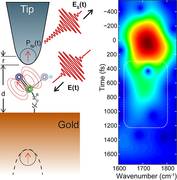Pushing the sample-size limit of infrared vibrational nanospectroscopy: From monolayer toward single molecule sensitivity
| Reviews and Highlights | Quantum Science | Molecular and Soft-matter | Ultrafast Nano-optics and Nanophotonics | Mineralogy and Geochemistry |
|---|
Xiaoji G. Xu, Mathias Rang, Ian M. Craig, and Markus B. Raschke
J. Phys. Chem. Lett. 3, 1836 (2012).
DOI PDF SI

While scattering-scanning near-field optical microscopy (s-SNOM) has demonstrated its potential to extend infrared (IR) spectroscopy into the nanometer scale, it has not yet reached its full potential in terms of spectroscopic sensitivity. We combine broadband femtosecond mid-IR excitation with an optimized spectral irradiance of ∼2W/ cm2/cm−1 (power/area/bandwidth) and a combination of tip- and substrate enhancement to demonstrate single-monolayer sensitivity with exceptional signal-to-noise ratio. Using interferometric time domain detection, the near-field IR s-SNOM spectral phase directly reflects the molecular vibrational resonances and their intrinsic line shapes. We probe the stretching resonance of ∼1000 carbonyl groups at 1700 cm−1 in a self-assembled monolayer of 16-mercaptohexadecanoic acid (MHDA) on an evaporated gold substrate with spectroscopic contrast and sensitivity of ≲100 vibrational oscillators. From these results we provide a roadmap for achieving true single-molecule IR vibrational spectroscopy in s-SNOM by implementing optical antenna resonant enhancement, increased spectral pump power, and improved detection schemes.
